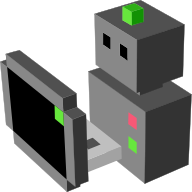Source code for morse.sensors.armature_pose
import logging; logger = logging.getLogger("morse." + __name__)
import math
import morse.core.sensor
from morse.core.services import service, async_service, interruptible
from morse.core import blenderapi
from morse.helpers.components import add_property
[docs]class ArmaturePose(morse.core.sensor.Sensor):
"""
The sensor streams the joint state (ie, the rotation or translation value
of each joint belonging to the armature) of its parent armature.
.. note::
This sensor **must** be added as a child of the armature
you want to sense. See the *Examples* section below for an example.
.. example::
robot = ATRV()
arm = KukaLWR()
robot.append(arm)
arm.translate(z=0.9)
arm_pose = ArmaturePose()
# the sensor is appended to the armature, *not* to the robot
arm.append(arm_pose)
This component only allows to *read* armature configuration. To change the
armature pose, you need an :doc:`armature actuator <../actuators/armature>`.
.. important::
To be valid, special care must be given when creating armatures. If you
want to add new one, please carefully read the :doc:`armature creation
<../../dev/armature_creation>` documentation.
.. note::
The data structure on datastream exported by the armature sensor
depends on the armature. It is a dictionary of pair `(joint name,
joint value)`. Joint values are either radians (for revolute joints)
or meters (for prismatic joints)
:sees: :doc:`armature actuator <../actuators/armature>`
:noautoexample:
"""
_name = "Armature Pose Sensor"
_short_desc = "Returns the joint state of a MORSE armature"
def __init__(self, obj, parent=None):
""" Constructor method.
Receives the reference to the Blender object.
The second parameter should be the name of the object's parent.
"""
logger.info('%s initialization' % obj.name)
# Call the constructor of the parent class
morse.core.sensor.Sensor.__init__(self, obj, parent)
self.armature = self._get_armature(self.bge_object)
if not self.armature:
logger.error("The armature pose sensor has not been parented to an armature! " + \
"This sensor must be a child of an armature. Check you scene.")
return
logger.debug("Found armature <%s>" % self.armature.name)
self._armature_actuator = None
# Define the variables in 'local_data'
for channel in self.armature.channels:
self.local_data[channel.name] = 0.0
logger.info('Component <%s> initialized, runs at %.2f Hz' % (self.bge_object.name, self.frequency))
def _get_armature(self, obj):
if hasattr(obj, "channels"):
return obj
elif not obj.parent:
logger.error("Could not find parent armature from armature sensor <%s>!" % self.name())
return None
else:
return self._get_armature(obj.parent)
def _get_armature_actuator(self):
# Get the reference to the class instance of the armature actuator
component_dict = blenderapi.persistantstorage().componentDict
if self.armature and self.armature.name in component_dict:
self._armature_actuator = component_dict[self.armature.name]
else:
logger.error("Could not find armature actuator <%s> from armature sensor <%s>!" % (self.armature.name, self.name()))
[docs] @service
def get_joints(self):
"""
Returns the list of joints of the armature.
:return: the (ordered) list of joints in the armature, from root to tip.
"""
return [c.name for c in self.armature.channels]
[docs] @service
def get_state(self):
"""
Returns the joint state of the armature, ie a dictionnary with joint
names as key and the corresponding rotation or translation as value
(respectively in radian or meters).
"""
joints = {}
# get the rotation of each channel
for channel in self.armature.channels:
joints[channel.name] = self.get_joint(channel.name)
return joints
[docs] @service
def get_joint(self, joint):
"""
Returns the *value* of a given joint, either:
- its absolute rotation in radian along its rotation axis, or
- it absolute translation in meters along its translation axis.
Throws an exception if the joint does not exist.
:param joint: the name of the joint in the armature.
"""
if not self._armature_actuator:
self._get_armature_actuator()
return self._armature_actuator._get_joint_value(joint) # reuse helper functions from armature actuator
[docs] @service
def get_joints_length(self):
"""
Returns a dict with the armature joints' names as key and
and the corresponding bone length as value (in meters).
"""
lengths_dict = {}
for channel in self.armature.channels:
# find the length of the current channel
#head = channel.pose_head
#tail = channel.pose_tail
diff = channel.pose_head - channel.pose_tail
length = math.sqrt(diff[0]**2 + diff[1]**2 + diff[2]**2)
lengths_dict[channel.name] = length
return lengths_dict
[docs] def default_action(self):
""" Get the x, y, z, yaw, pitch and roll of the armature,
and the rotation angle for each of the segments. """
if not self.armature:
return
if not self._armature_actuator:
self._get_armature_actuator()
joints = self.get_state()
for k,v in joints.items():
self.local_data[k] = v
